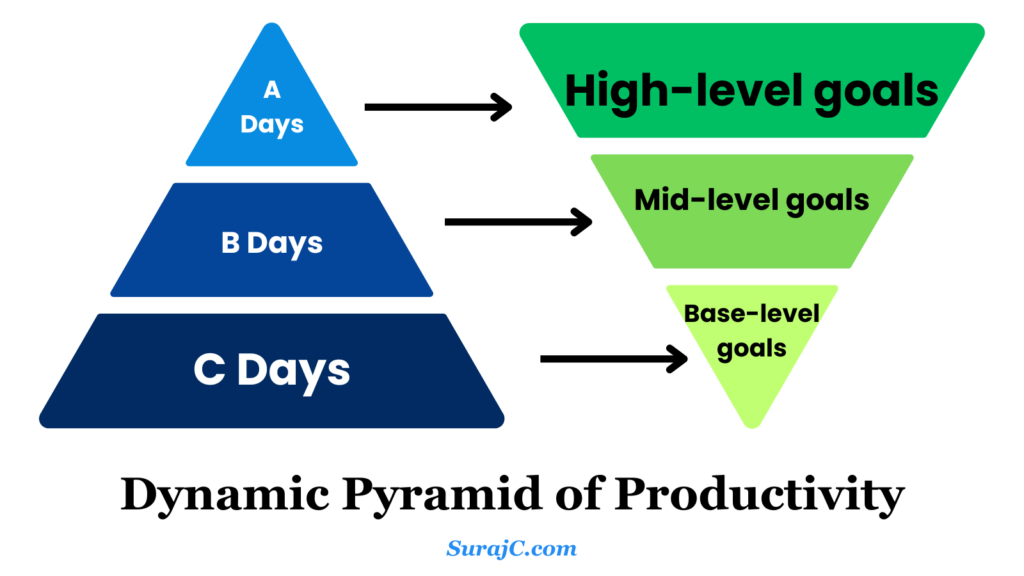
One lesson, thought, or resource to living a fuller life every week. Some bonus episodes here and there.
Suraj Chaudhary is a writer, developer, founder, and a constant learner. He shares lessons and resource to living a fuller life every week.
In this week's episode, I share with you the Dynamic Pyramid of Productivity which will allow you to be productive every single day.
At the core, we use something called the dynamic goal-setting.
Suraj Chaudhary is a writer, developer, founder, and a constant learner. He shares lessons and resource to living a fuller life every week.
Connect with me: surajc.com

Dear reader,
A couple of weeks ago, I found this insanely effective method to make every single day productive.
Yes, that includes our lowest days.
Really short context: For the past 5-6 years, I get sick once a year. It is for a week and this week, I have to take bed rest. That is how sick I get.
So that week occurred recently. I was sick, weak, and drained.
Being the productivity nerd that I am, it was really difficult not being able to get anything done.
That is when I remembered this quote I had heard really long back:
Any progress–big or small–is progress.
This got me thinking about the fact that we cannot sustain the same level of energy every day. Sometimes life happens.
So what do we do? How do we turn our lowest days into productive days?
We use what I call the “Dynamic Pyramid of Productivity.”
Well, holistically, there are 3 types of days we can have:
- A Days: On these days, we are at our best. We have high energy, and great drive, which leads to high productivity.
- B Days: These are our most days. We have mid-level energy. We can do things but gotta push ourselves a little.
- C Days: These are the worst days we have. Life happens, we overthink and procrastinate a lot, or maybe we are sick.
It would be natural to let our C days pass without doing anything. But when that happens, we feel bad about wasting the day.
That is where our Dynamic Pyramid of Productivity comes in.
This pyramid uses dynamic goal setting as the core tool.

For our A days, we set our A goals which are also high-level goals.
These goals require high energy and focus. A few examples of our A goals could be working out in the gym for 2-3 hours, taking a long run, or maybe practicing deep work for 3-4 hours.
For our B days, we set our mid-level goals.
Since we aren’t super motivated but aren’t demotivated either, these goals have to be achievable. If we set highly demanding goals but don’t have the same level of drive, we might end up feeling bad at the end of the day.
A few examples of our B goals could be working out for an hour at the gym, taking a 30-minute walk, or working deeply for an hour or two.
Then comes our C days.
Recall that C days are the worst days we have. We don’t feel like doing anything. And if we are not strategic about it, we might end up doing nothing.
So for these days, we have to set our base-level goals.
These goals have to be comparatively easy to achieve. A few examples include doing 10 pushups at home, taking a short 15-minute walk around the neighborhood, or a 30-minute deep work or study session.
The thing that we are trying to avoid by using the Dynamic Pyramid of Productivity is breaking the chain.
Sometimes we get in the rhythm of doing things, we are in the flow of being productive.
During these good days, if we don’t be productive for even a single day, the chain, and the rhythm are broken.
And once this happens, we are very likely to slouch for multiple days.
That is what dynamic goal-setting allows us to avoid.
Here is what I want you to learn from this article:
Takeaway: We can’t be productive every day. Recognize that and set goals accordingly, high-level goals for good days and base-level goals for bad days. Any progress–big or small–is progress.
This week’s question for you: What would an A day look like for you?
It is nice to have you here, seriously.
In this era of distraction, your taking the time to read this, and actively trying to improve your life is commendable.
Good luck, mate! You’ve got this.
If you read till the end, do let me know your answer through a comment.
I’ll write again next week.
See you then!
Warmly,
Suraj
PS: I made a video about this, click here to watch it.

